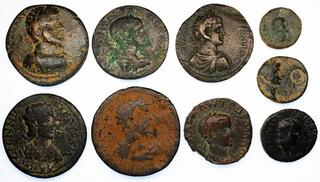Lot description:
Roman Empire, a Selection of Provincial Bronze (9): i) Claudius, AE, Phrygia, Hierapolis, laureate head right, countermarked with the head of Helios, right, rev. Apollo standing right, holding plectrum and cithara, 4.15g (SNG Copenhagen 453; Countermark Howgego 11; RPC 2969), fine; ii) Nero, AE, Iconium, laureate head of Nero right, rev. veiled head of Perseus right, with harpa over shoulder, 4.93g (RPC 3545), softened but fine; iii) Lucius Verus, AE Medallion, Pontus, Cilicia, Tarsus, laureate, draped and cuirassed bust right, rev. two emperors, togate and carrying scrolls, facing one another and shaking hands, SEBASTON in exergue, 20.37g (Unpublished), some lamination, bright patina, fine, a rare and unpublished variety; iv) Commodus AE, Mysia, c. 184-190, draped and laureate, draped and cuirassed bust right, rev. galley with rowers, 19.30g (RPC Temp. 2329), fine; v) Caracalla, AE, Pontus, Amasia, c. 205-208, laureate, draped and cuirassed bust right, rev. high altar with sacred tree to left, 14.01g (BMC 32; Dalaison 385), rare, nice portrait and patina, good fine; vi) Gordian (AD 238-244), AE 25, Capadoccia, Yr 6=AD 243, laureate, draped and cuirassed bust right, rev. Argaeus set on altar, date in exergue, 11.05g (RPC 3381), red patina, good fine; vii) Gordian, another, Pontus, Neocaesarea, laureate, draped and cuirassed bust right, rev. Prize urn containing two palms on an altar decorated with a palm on the front, 15.74g (Falghera 2103), green patina, deposits, fine; viii) Herennia Etruscilla AE 31, Phrygia, Alexandros, son of Tieios, first archon, diademed and draped bust right, rev. Tyche standing facing, head to left, holding rudder and cornucopiae,12.84g (RPC 840; SNG von Aulock 3885; SNG Leypold 1690), fine; ix) another, Vespasian(?), 3.90g, fine (9)..
Estimate: £200 - £300 |  |